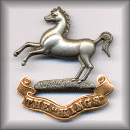















|
"The Story of the 9th King's in France"
LEMPIRE
The train journey lasted all day and the Battalion detrained at Bapaume, and by a night march on a bright moonlight night marched to a Nissen hut camp between Barastre and Haplincourt, where it sojourned for a few days. During this time a few of the non commissioned officers were able to visit the Somme battlefield, and locate a few of the graves of the men who had fallen a little over twelve months ago. A day's march on the 1st October brought the Battalion to Aizecourt le Bas, and after a night's rest it proceeded to St. Emilie, where the men were billeted amid the ruins of what had formerly been a sugar factory. During the march it was made plainly evident to all with what thoroughness the work of destruction had been carried out by the Germans. The villages were not merely in ruins. Every house and every room had been rendered useless as a billet or shelter of any kind. The cellars had been filled with stones or refuse, so that even these were of no use. The trees had all been wantonly destroyed. Even small fruit trees of only a few years' growth did not escape the axe. The wells had all been blown in, and in many cases they were poisoned as well. The churches were treated exactly the same as the houses. The whole region was desolate. There were no civilian inhabitants, and soldiers were the only occupants of this wilderness.
After a few days in the Sugar Factory the Battalion moved to the forward positions at Lempire. This sector was very different from any sector the Battalion had occupied. There was no trench system comprising front and support trenches. The front was held by means of isolated posts occupied by a platoon or a company as the case might be, and these posts were linked up by means of communication trenches, so that they could be visited. There being little artillery on either side, the whole sector was very quiet, and as the lines were far apart there was little sniping.
The Battalion did one tour in Cat, Fleeceall and Grafton Posts in front of Lempire, and then moved up to the Ossus sector. Though the Germans had destroyed all buildings behind the British line, the buildings behind the German lines were intact, and the men experienced the unpleasant sight of the comfortable chateaux and houses in which the German troops were billeted when they themselves were very badly off in this respect.
Three companies had been in the front in the Lempire position, and as three companies were necessary to take over the Ossus sector, one company had to do two successive tours. It was a poor relief to have to move from one portion of the front line to another, especially as this company had only one subaltern. The sector held by the Battalion was roughly 2,000 yards, and consequently the three front companies each had from six to seven hundred yards. The trench strength of the companies was somewhere between eighty and ninety, the numbers not having been made up after the Ypres casualties, and consequently there was a great amount of work for everyone to do.
On the 18th the Battalion moved to reserve at Vaughan's Bank by Epéhy, from whence on the 22nd it moved into reserve at Tincourt. The American Railway Engineers had constructed a light railway from Epéhy to Tincourt, and they expressed their readiness to convey the Battalion there by rail. Their offer was gladly accepted, and the Battalion duly arrived at the station and entrained. There was a slight incline to commence and the numbers that arrived exceeded the haulage capacity of the only serviceable locomotive at the station, and consequently no progress was made. As there was no telegraph a message had to be sent on foot for another engine, which came along after a long wait, and eventually a start was made. The couplings were bad and the train soon broke into three portions. As the way was downhill the various sections glided down to the next station independently. Here there was another train and a loop line, and it also happened that one train was too long for the loop. Nothing daunted, the railway engineers indulged in a considerable amount of shunting, and decided to take a portion of the waiting train back with the troop train. All went well until the next incline was reached. There was a great strain on the engine, but eventually after charging the hill three or four times, accompanied by much racing of engines and skidding of wheels, the top was reached, and the Battalion got to Tincourt having taken on the journey twice the time it would have taken to march the distance.
At Tincourt a pleasant week was spent, after which the Battalion returned to the Birdcage sector, the portion of which immediately in front of Eagle Quarry was the scene of much minenwerfer activity.
|